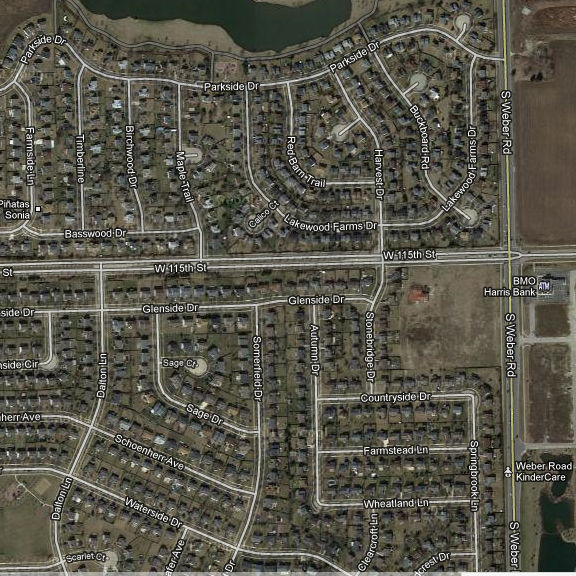My house stands on what used to be someone’s farm. Their home was here. Their family lived out every day on this land, under this sky. There were crops, animals, and outbuildings. Now, there are dozens, if not hundreds, of houses, here. Not much is left from the farm days but a few kitchy street names: Farmside, Harvest, Calico, Red Barn. (Well, there is one old tree, and a fence post.)
But one day last year I came across something else. Bolingbrook’s library has a small room set aside for local history. Once I was digging around in there, paging through newsletters published by the Bolingbrook Historical Society, and I found a column written almost twenty years ago by a man who grew up, literally, on the same land our house stands on. His family had farmed here since the 1830s and 40s.
He remembers it like this: My childhood was spent on a farm along a peaceful country road where perhaps a dozen or so cars passed each day. Set back off the road and nestled among the maple and cottonwood trees were the old barn and farm buildings as well as the wonderful house my parents built.
He writes about his love for that house, the barns, a stone-lined well, and an “old pot-bellied stove in the old garage.” But times were changing. His family’s story is the story of many farm families in the late 20th century: …over the years, the one-lane, gravel road became a busy thoroughfare, known now as Weber Road. Neighbors and friends began to move away as the rural setting changed.
His family sold their land to a developer in the early 1990s. And in 1994, the house was burned to the ground for fire department practice. I didn’t go by to watch. I waited a few days before I poked around in the ashes and kicked the scorched earth.
He writes, painfully: It was difficult, now, to imagine the neat lawn where we could lie on Fourth of July and view the fireworks displays of a dozen or more communities in the distance. … Too, it was difficult to imagine our large table where there was always room for one more person at dinnertime… It was difficult to imagine this was the place of my childhood games of “Kick the Can” or dreams… under the old apple tree or “idle” walks along the old fence rows… No more excitement of finding the first new litter of kittens each spring and no more runs up the long, gravel lane after an endless bus ride home from school.
The author, Michael Lambert, is a founder of the Will County Historic Preservation Commission. He’s been writing about local history for a long time, and his name continues to pop up in local news articles on preservation.
I could give him a call and have lunch with him.
He names nearby Plainfield as his hometown, not Bolingbrook, which I can understand. Plainfield, although its farms also have been bulldozed and covered over with homes, was the local farm town for this area and still has its old main street. Bolingbrook is a town that was created by developers, some of whom burned down my childhood, as Lambert says.
He says towards the end of this column, with what seems to me both grief and realism: I am a preservationist because I realize – no matter what we do save – that nothing truly stays the same.
Future column: The History of My Subdivision, Part II – The Indian Boundary Line




The phrase “burned down my childhood” is just unspeakably sad. Though, I hope the children growing up in the subdivision are having happy childhoods on the same beloved land.
I lived in Colonial Village. I went to all of the schools in Romeoville and Bolingbrook. We lived on Queenswood Rd. We lived there from 1962 to 1970. I had a great childhood there.